
I’m in Olympia, Washington, at the state Capitol, John Cherberg Building,Hearing Room No. 3 for today’s hearings of the state Clemency and Pardons Board.
This is where people looking to get old felonies off their records and people looking to get out of prison before their sentences are up come when they have no more recourse through the courts — to be recommended for clemencies or pardons to the governor by her handpicked panel of law-and-justice experts.
It’s where I get the stories that will be in my true-crime book.
Much to my surprise and pleasure, I found that I not only got a good seat, but had strong wireless Internet access and a ready outlet for my laptop. So, on the spur of the moment, knowing how dramatic these hearings can get, I decided to live-blog — with pictures! — the day’s proceedings.
Please join me … and check in throughout the day. There are nine cases on today’s agenda … at least three of which have been put forth by convicted murderers. It’s packed house here so far, standing room only, with family members and supporters of the petitioners eager to state their cases.
The hearing should start just after 10 a.m. Pacific time.
*****

10:03 a.m.
Just two of the five board members present! One is participating by conference call, so two are absent. Yikes.
Present are board chairwoman Margaret Smith, a Seattle defense attorney who works in the federal court system; and Snohomish Police Chief John Turner. On the phone is criminal defense attorney Amanda Lee.
Honestly, if I were a petitioner before the board today, potentially with my future hanging in the balance, I’d feel a little bit cheated.
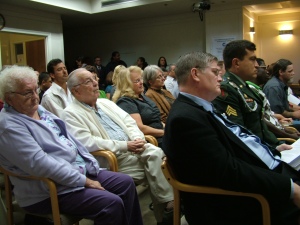
*****
10:08 a.m.
Seferina Medrano is the first case. It’s pretty routine. She’s asking to have her civil rights restored after a drug conviction in the federal court system. It was approved within about 30 seconds.
****
10:10 a.m.
Willeen Ballard is the next case. In 1992, she was convicted in Spokane County of running over a man she carjacked and robbed. The man died. And that’s an old crime; not the one for which she is currently imprisoned. They’re getting her on speakerphone from the Washington Corrections Center for Women in Purdy. No one’s speaking in opposition. She’s being represented by Sheryl Ann McCloud, a Seattle attorney who specializes in these cases. She’s a frequent presence at these hearings, and has a pretty high success rate.
She’s accompanied by a man named Don Wohlers, described as Ballard’s “biggest supporter.
Ballard is 42, and has had “an extremely hard and abusive childhood.” Like her mother, she lapsed into drugs and prostitution as a teenager; later she became a mother whose child — as well as she — were regularly abused by the men who drifted through her life. There were suicide attempts, and as a result, “organic brain damage” set in.
Her crimes, McCloud says, stemmed from her drug addiction. “When she’s been clean, there’s been no crimes,” McCloud says.
She was clean from 1999 to 2002.
Ballard is now on the line, and McCloud will continue talking for now.
Crime for which she’s currently incarcerated: Car theft with injuries against an 82-year-old woman. (I haven’t seen the paperwork yet, so I can’t say what the specifics are yet.) She’s doing 25 years for the carjacking; been in for 7 years now (went in November 2002).
She didn’t do well in prison at first, racking up infractions. But then her brother died in 2005, and “she snapped in a good way,” McCloud says. She changed, stopped accumulating infractions, is now in counseling, works, takes community college classes. She’s got support lined up — “a whole cul-de-sac neighborhood of people who will emotionally support her” and take her in, McCloud says.
Her official state Department of Corrections risk assessment says she’s “low-risk” when she’s off drugs.
July 7, 2019 is her earliest release date as things stand now.
The King County prosecutor opposes clemency. It’s a “three-strike” case, and the deputy prosecutor who worte the letter notes that Ballard accepted her sentence in a plea deal. But, McCloud argues, it’s debatable as to whether Dan Satterberg, the current prosecutor, would see her crime as not being a three-strikes crime.
But, Margaret Smith on the board interjects: “A deal is a deal, and this board has usually be hesitant to overturn deals.” But, she says, “I understand that 300 months was bargained for when lief in prison was the only alternative available to her.” And now Satterberg has questioned whether other three-strikes life-in-prison recipients
should have gotten those sentences. In fact, several of those cases have been successfully pleaded before the board by McCloud, with Satterberg’s concurrence.
Smith says this case is different, however, because of Ballard’s extensive criminal history and that she has done relatively little of her sentence. And in 2002, when the crime happened, King County had decided they had more discretion in three-strikes cases than they thought they did under the controversial 1994 three-strikes-and-you’re-out law.
John Turner says he’s “troubled” by the lack of time that’s elapsed. Seven years — and really, less than that — is too little time for him to be sold on a definitive change in Ballard for the better, he says.
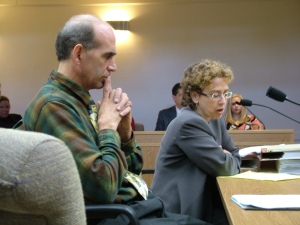
Wohlers speaks: His first claim is that Ballard was “set up” with a hashish-laced cigarette in prison, and shouldn’t count in her infractions. Other prisoners are jealous of her, because of the attention he says, and are out to get her. This traditionally is a very poor argument before the board. They want to hear accountability and ownership of bad behavior, not a litany of victimhood.
Wohlers has known her for “a most amazing” 21 months. “Look beyond the past and create a door for Willeen to pass through,” he says. “The anger, the hatred, the woe-is-me attitude, is gone.”
He’s pretty whiny, honestly. He’s way too emotional.
“Peace, love and happiness will be our motto,” says Wohlers.
Willeen will live at his Bellingham house, but have her own room, he says. “We will develop a relationship,” he says.
Her sister will offer Ballard a job at her restaurant, McCloud says.
Wohlers’ mother and brothers have met her and like her. In all, 18 people have come in support.
It’s Willeen’s turn to talk.
“All my life I’ve been hurt and hurt other people. I hurt someone else who didn’t deserve it because I was on drugs,” she says over the speakerphone. She emphasizes that she worked on herself before she knew about the Clemency and Pardons Board. “I’m not changing my life to impress anyone,” she says.
“I would hurt myself before I’d ever hurt another person ever again,” she says.
She claims she was sexually assaulted by corrections officers as well as by fellow inmates. She’s choking up now, dissolving into tears.
Younger sister Rhonda Ballard speaks: “Willeen chose the wrong way, became a hard person, a tough person. … She’s exhibited to me remarkable reform since she’s been in prison, she’s exhibited remorse.” Religion’s been a strong part of Willeen’s redemption, she says.
“I look forward to having Willeen working next to me and having her in my life.”
Turner wants to know more about the alleged drug setup.
“Yeah, I took a puff off of a cigarette, which was against the rules,” she says. “I felt that was done to keep me in prison, which is a very hard place.”
Turner: “I am troubled by the issue of time that has passed, and not passed.”
It’s motion time.
And Smith says she’s movi9ng to deny Willeen Ballard’s petition. Turner seconds it.
Says Smith: “Tou have many, many positive influences in your life, and I hope you will continue down that road.”
But, “I do not believe extraordinary circumstances exist that merit clemency. … I think the passage of time of only seven years is persuasive to me. … With the exception of a three-year period, you’ve used drugs and committed crimes, except when you’ve been incarceatred. I think you need a little more time.”
Says Turner: “The issue with the agreed-upon sentence weighs on me.”
He is impressed with the support structure, “and it is the basis for any success.”
He adds: “I’m just trouble by the amount of time and the severity of the crime.”
Amanda Lee weighs in. “There definitely are some extraordinary cirucmstances … the history of family drug and sexual abuse. So I wouldn’t say no extraordinary circumstances exist.”
But, “I share the same concerns as my fellow board members. … I’m hoping there’s a point in the not-too-distant future that the prosecutor’s office could agree that, yeah, this is too long a sentence.” But, she made clear, that time has not yet arrived.
“We need to see a little bit more time (for you) to demonstrate the sort of extraordinary rehabilitation that the governor could respond to.”
The vote is 3-0 to deny Willeen Ballard’s petition. Honestly, I saw that one coming.
Time for a short break.
*****
11:12 a.m.
Next case: Aaron Borrero. He’s also being represented by Sheryl McCloud, and about three dozen supporters are here for him. Lot of high school friends, and several people who have job offers. Not sure yet what Borrero’s crime is; again, I haven’t gotten to preview the paperwork.
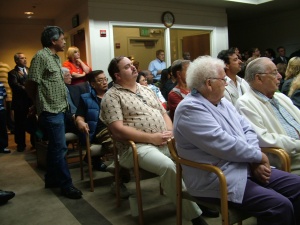
Actually, it looks like nearly 50 people are here for him. Wow. I hope with that much going for him, that his case is a little stronger than Willeen Ballard’s. Among those present are his son, Angel, who looks like he’s about eight years old, and Angel’s mother.
Biggest of all: His victim, “who was almost murdered,” is here to speak … for him. That’s huger than huge. I predict victory just on that basis.
Shall we find out just who Aaron is?
Says McCloud: 1998 was the crime. (WHAT crime???) And McCloud says, since 2000, he’s cleaned up his act — helped by transferring from the state penitentiary in Walla Walla to the state reformatory in Monroe. He’s had 50 to 60 clean drug tests since then.
In 2001, he paid off his legal and financial obligations. “Extraordinary,” McCloud said. Also extraordinary: A few years later, Borreo caught up _ and kept current with — his child-support obligations, thanks to a well-paying job in prison doing metal fabricating.
(I know, I know … but what was his crime????)
He’s done so much good volunteer and school work in prison, McCloud says, that the prison administrator made a rare exception for him a few years back — allowed him trailer visits with the mother of his child even though she had something on her record that normally would preclude that. Said the administrator: “It’s because of his commitment to building strong family relationships.”
He was transferred to McNeil Island last year.
He’s 35 now, “a leader, a mentor and a role model,” McCloud says.
He’s got five job offers and several places to live, should he be freed.
(The crime??????)
The request: Commute an almost-23-year sentence, for which he has served almost 11 years.
Les LeMieux, the victim of attempted murder and kidnapping: “I am not objecting to Aaron Borrero’s request to clemency. … I don’t know Aaron, I don’t know him personally, but I believe he’s changed.”
LeMieux himself has spent two years in federal prison, and speaks from that experience. The crime, he said, was “a business decision.”
“The man could not have gotten close to me unless he was very good at what he was doing.” LeMieux speaks, he says, as a “pre-eminent” high-level set-the-market marijuana dealer in the Seattle area in the late 1990s.
“What he did was a business decision, and there’s no way he could spend all this time in prison and not come to the conclusion that this a business he should still be in.”
LeMieux was tied up with copper wire and thrown into a freezing river. “I believe they didn’t know the chemical composition of copper very well, because I was able to break the bonds very easily,” he says.
In sum, “I think he can be an asset to the community and his children.”
Says Smith: “The fact that you’re alive is very fortunate and has nothing to do with what he did.”
LeMieux agrees, but says Borrero’s done enough time. “If he were to be put into a legitimate business, I have no doubt he would do very well.”
Boy, do I need to talk to this guy. He’s fascinating, very articulate, even joking a little.
Turner says it’s huge that the victim is speaking on behalf of the defendant.
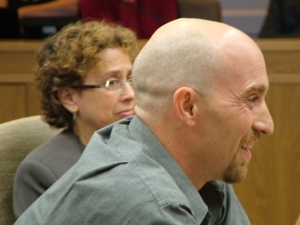
That’s LeMieux, above, with Sheryl McCloud.
“I wouldn’t support any kind of clemency for anybody who hadn’t shown any kind of remorse,” he said. That was helped by the fact that he had gotten Borrero to write a letter to McCloud explaining his crime — presumably to see if he had minimized his conduct.
“It’s a terrible crime, but it was business and not personal,” he says.
Amanda Lee asks: “Does it makes sense to you that Mr. Borrero could have changed in the time he’s spent inside?”
LeMieux: “I think so … the fact that he has so much to go back to on the outside has a lot to do with it.”
In prison, “there is nothing you can do but take care of yourself. The only thing you have is your own body.”
In his mind, “he must be better,” LeMieux says.
“Some people think of prisons as gladiator academies and graduate programs for criminals, but I don’t think that has to be the case.”
He’s done, and now he’s gone. Wow, he’s fascinating. I’ve got to sit down with this dude.
Now it’s Aaron Borrero’s turn. “I’m not going to put sugar on poo and try to make it taste better,” he begins.
For a few minutes, he speaks with humility about his regrets.
Then it’s time for a few people to speak on his behalf. First up is Bill Klatt, who administered the metal fabricating program Aaron worked under in prison. Next is a very emotional man named Randy Dyer. He’s weeping at the table. I
n 1972, he says, he was involved in a kidnapping and spent three years in a federal prison, he says. Since 1979, he’s volunteered in prison, had three kids, brought religious teaching to inmates.
Aaron, he says, has changed because he accepted Jesus Christ as his savior.
Next up is Carol Estes, who teaches in the prisons. She’s written behalf on three other inmates who received clemency in the last year — Gerald Hankerson, Kareem Al-Shadeed and Steven Dozier. She’s volunteered for nine years, worked with a few hundred prisoners, and this is her fourth letter. She and Borrero have been involved in the University Behind Bars program.
“He’s not one of the best, he is the best,” Estes says. “One of the most committed and disciplined students I’ve ever known.”
“He not only recruited men to the program, he got them truly excited about the possibilities of being a small business owner,” she added. “And he did it across racial lines.”
“If you recommend clemency for Aaron, you’ll be releasing a young man who has a lot to offer the world.”
Last up is cousin Jason Lazaro. They were the same age, were close growing up.
“It was very clear he was going down that destructive road,” he says. “He got whatever he wanted because he was the star athlete. … For Aaron, it started to steamroll and it just got out of control. Prison probably saved his life.”
Jason noticed the positive changes in his cousin starting in 2001. “He’s ready to be there for his community, for his family, for his child,” he says.
“He’s admitted remorse to me, back in 2001,” Jason continues. “We will not let him fall down.”
McCloud wraps things up, and equates Les LeMieux’s struggles to forgive Borrero to the struggles the board must face. “I would urge you to follow Les’ lead,” she says.
The letter from the King County prosecutor opposes the clemency, Smith says. But Turner says the latter falls short of an opposition, merely that the prosecutor’s office doesn’t support the clemency.
Turner moves for commutation, and the room bursts into applause.
“I find it extraordinary that Mr. LeMieux not only takes the stand he does, but that he was here to tell us why,” Turner says. He also cites the huge support in the room, plus the offers of homes and jobs. Together, he finds them persuasive.
Amanda Lee weighs in. Or does she? She’s no longer on the phone! The board needs a break because they need three votes for a quorum. Ah, technical difficulties. How much did Lee miss?
*****
12:16 p.m.
We are back. Lee is back, and she missed nothing. Only Turner’s now taken a potty break!
And now he’s back.
Turner corrects himself: The prosecutor’s office, he now agrees, does oppose the clemency. But that won’t change his position, he says.
Lee says she’ll second the motion to recommend the governor grant clemency to Steven Borrero. More happy gasps and applause.
She, too, is swayed by LeMieux’s testimony, which she cites as “unique” in her experience. “I find it extraordinary that he stood his ground in the face of opposition from his family,” she says.
“I think the time that has passed since this crime has been used exceedingly well … and he deserves an opportunity to rejoin his family.”
Chairwoman Smith agrees. “I don’t think there’s any issue of future dangerousness,” she adds.
It’s official: 3-0, for clemency. More applause, lots of hugs.
Next up: The case of Bob Kaseweter.
*****
Here’s the Borrero-Lemieux story, according to a Caselaw link found by loyal reader Jeremy Lape:
In March 1997, Leslie Lemieux delivered a duffel bag filled with 30
pounds of marijuana to Kyle Anderson’s house. When Lemieux walked into
Anderson’s house, Borrero and Michael Vaughn put guns to his chest and
head. After forcing Lemieux to the ground, Borrero tied his hands and
feet, bound his hands and feet together, and blindfolded him. Borrero and
Vaughn then stuffed Lemieux in a duffel bag and carried him out to his
vehicle.
Anderson, Borrero, and Vaughn drove off in three separate vehicles. Vaughn
drove Lemieux’s car with Lemieux stuffed in the back. After several hours
of driving, Borrero and Vaughn stopped near the Yakima River. They took
Lemieux out of his car and dumped him into the river. After watching him
float away, Vaughn and Borrero left. Lemieux eventually managed to get out
of the river and find safety. The police arrested Borrero in California
two months later.
The State initially charged Borrero, Anderson, and Vaughn with
kidnapping in the first degree and assault in the first degree. Vaughn
negotiated a plea agreement with the State. Under the terms of that
agreement, he pleaded guilty to one count of first degree kidnapping in
exchange for testifying truthfully against Borrero and Anderson. By
amended information filed more than four months before trial, the State
increased the first degree assault charge against Borrero and Anderson to
first degree attempted murder.
Borrero and Anderson were tried separately. The jury convicted
Borrero of first degree kidnapping and first degree attempted murder.
*****
12:26 p.m.
Kaseweter is up.
Jacquie McMurtrie, from the Innocence Project Northwest, is the counsel. This should be interesting. They’ve been working on his case for seven years.
Kaseweter has been in prison since 1992 for kidnapping. He has a wife and a 14-year-old daughter. Like him, they’ll be testifying by speakerphone. (“Testimony” is actually a misnomer, as the board hearings are not judicial proceedings.)
His earliest possible release date: October 2010.
Two key witnesses are the trial have recanted their testimonies. The court decided one of the men — they’re bothers — wasn’t credible.
I can see this is going to be a complicated narrative … multiple conspirators, several people rolling over on other people for various reasons, and apparently Kaseweter was the domino at the bottom of the pile. All but Kaseweter are out of prison. I really need to get hold of the case file and sort this all out.
OK, what about the victims? “It was horrible, terrifying,” McMurtrie admits. Smith says the victims are convinced that he was the ringleader.
Apparently Kaseweter was engaged, but was suspicious that his fiance was cheating on him. He enlisted friends to help him find out for sure. He confirmed that there was cheating … and that led to a breakup, and Kaseweter’s subsequent crash into depression. Then, the kidnapping. (OK, where did this happen????)
“Everybody who knows him knows that he would not engage in or condone an act of violence,” McMurtrie says, “and the fact that apparently incited someone to do these things for him was completely out of character.”
Chairwoman Smith is skeptical, and cites evidence and testimony from the investigation.
McMurtrie says the co-conspirators basically goaded Kaseweter into retaliating against the fiance because they felt he was too passive and mopey after the breakup.
“But I think we want to focus on Bob Kaseweter, who he is now,” she says.
She’s asking for a commutation and a pardon … and the Innocence Project believes he’s innocent. (I’m mystified, too … please bear with me.)
He taught himself Hebrew in prison so he could read the original Old Testament, McMurtrie says.
OK, found a story online about the Kaseweter case. Not sure it clears up much, though.
About 20 people are here on his behalf.
Speaking now is Rev. Thomas Dunbar. He’s known Kaseweter in 1991, in McAllen, Texas. “His one desire, as it was shown to us, was that he was grow in knowledge of Jesus and put into practice what he’s learned,” Dunbar says.
“My wife and I believe … that he was falsely accused,” he adds. “We were totally surprised when we heard the guilty verdict.”
He has been able to resist the temptations of prison life, Dunbar says. In prison, though, he’s been attacked, robbed and falsely accused, but “carries his spirit of forgiveness,” Dunbar says. He’s now imprisoned at McNeil Island.
I have to say, this is an unusual presentation. His supporters seem to be spending a lot of time making the case that he’s a good person who’s become a better person during his years in prison … but why would they even feel the need to make that case if they believe there was nothing for him to make up for? (Yes, I’m aware that’s a terrible sentence.) It seems to me that the Clemency and Pardons Board is maybe not the right venue for this case. But then again, it is the court of last resort, and perhaps his supporters have exhausted their avenues of appeal within the court system.
It’s Mrs. Rosemarie Kaseweter’s turn. She’s here from South Bend, Indiana. She’s made 34 trips in 16 years on this case. They — she and their daughter — spend a month in the summer and the holidays in Washington visiting him in prison.
And now, we learn that a request for a new trial was in fact denied, in 1995. Together, “we turned Bob in, in Vancouver, Washington.”
(I’m sorry; I know this doesn’t make much sense.)
She continues: He’s the most loving, gentle, Christian man. He helps other inmates write letters.
One of his infractions: Having too many postage stamps. Another: Leaving his laundry in the prison laundry room over the weekend.
He got 17 years in prison, for five different felonies. But because he wasn’t seen as a threat, he was freed on bond during the appeal process, around 1993. (Sorry, backing and filling in with facts as we go.)
“All Bob wants to do is help. … He’s still the gentlest person I’ve ever known in my life.”
Now, the 14-year-old-daughter is speaking.
“He’s the best father that anybody could be over 2,200 miles away and incarcerated my whole life,” she began. “For the past seven years, he has had teacher conferences with my teachers to see how I am doing academically. … He would narrate books on tapes when I was little, like The Magician’s Nephew and The Old Man and The Sea.”
When she was five years old, they wrote a story together by mail, going back and forth.
She’s choking up now.
“He said, ‘My duty as a parent to you is to make you happy,'” she says. “He still disciplines me from 2,200 miles away … no makeup, no piercings, no tattoos.”
“When he gets out, we’ll have a lot more fun than we could have playing Wheel Of Fortune in a visiting room.”
Now, it’s time for the Clark County Prosecuting Attorney’s office to retort, in opposition. Bob Shannon is the speaker.
“There are victims in this case, and they do oppose clemency,” Shannon begins. “Even though so many years have passed, they wish him to serve his determined sentence.”
What about the recanted testimony? Smith asks. Shannon believes that the original testimony of the witness was credible and fit with the facts of the investigation.
Now McMurtrie’s back, to wrap up.
But Amanda Lee breaks in with questions about the crime, and the co-conspirators. Apparently there was longstanding animosity between the victim and the (allegedly) contracted kidnapper — they’d worked together at a Schuck’s Auto Parts store and didn’t get along, McMurtrie says.
“The idea that (Kaseweter) would have her beat up to get her to come back to him doesn’t make any sense,” McMurtrie says, clearly implying that the “hitman” acted on his own — out of his own animosity toward the victim.
McMurtrie’s co-counsel — a woman named Canary — says that even if Clark County’s understanding of the facts is correct, that understanding doesn’t really understanding who Bob Kaseweter is now.
Canary says that at one point, Kaseweter was beaten so badly in prison that his skull was fractured and that he was flown to Harborview Medical Center in Seattle. His friends in prison wanted to retaliate against the assailant as soon as he got out of “the hole,” they told him via letters, according to Canary. But Kaseweter convinced them to let it go.
As for support? “This room would be full if it was South Bend, Indiana,” Canary says.
“Or in prison,” Smith adds wryly.
More praise for his kindness, his gentleness, his thoughtfulness and his intelligence ….
“He truly is exceptional,” Canary finishes.
No words from Kaseweter, who is listening in. Apparently he made a video for the board earlier. I need to see that!
Now it’s time for the board to deliberate.
Turner sounds skeptical to start with. He is impressed by Kaseweter’s support group, however.
But, “I have to look at the facts,” he says. “Whether he’s guilty or innocent is not an issue for the board.” He’s not impressed by the recanting. He’s swayed by seven pages of testimony from the victims. “Once a victim is a victim, they’re victims forever, and their concerns have to be considered.”
Turner says he’ll move to oppose the petition, and notes that Kaseweter’s earliest possible release date is just 11 months away.
Now it’s Lee’s turn to speak.
(Some clarification: He’s eligible to be transferred to a work-release camp in March or April 2010, and be freed altogether by October 2010.)
Lee’s thoughts: She agrees that it’s not appropriate for the board to “revisit the facts.” She feels Kaseweter was well-presented.
“I am torn, frankly, by all the information,” she concedes, but ultimately she won’t take up the matter of guilt or innocence.
The early release date works against him, Lee says. She’s concerned that a positive recommendation would be more of a “referendum on the trial than on rehabilitation.”
Now Smith speaks. She can’t support a pardon, and she doesn’t believe that an innocent man has been wrongly imprisoned. Commutation? She agrees with Lee, and won’t support that as well.
She’s impressed by Kaseweter’s “remarkable attitude,” however.
“Unfortunately, I cannot support what you’re asking me to support,” she says. “And it disappoints me to disappoint you.”
The vote is in: 3-0 to deny a pardon, and to deny a commuted sentence.
Break time. Lunch break this time. Whew. I need to pee.
*****
2:09 p.m.
We are back.
Next up: Patricia Teafatiller. Her attorney is John Cain. She’s on the phone from the women’s prison.
This case came up a year before: In her early 20s, about 15 years ago in Vancouver, Wash. Teafatiller was a young wife and mother despondent over her husband’s relationship with another woman. She decided to get his attention by making slash marks on the throats of herself and her two young daughters. She claimed it was a gesture, and the wounds were not extremely deep, but she was charged and convicted of two counts of attempted murder. She’s a little over 14 years into a 40-year prison sentence.
She came up for clemency a year before, and was denied. Not sure why she’s back now; usually the board wants a minimum of two years between hearings for people they’ve turned down. Apparently, Cain is saying, there are witnesses here to speak today who weren’t available during the 2008 hearing.
Nobody is here to speak against Teafatiller; the Clark County prosecutor’s office has sent in a letter in opposition, however.
A mental-health professional is speaking now about Teafatiller’s own childhood abuse. She says that the childhood abuse, coupled with a physically and emotionally abusive marriage in which drugs were also involved, created post-tramautic stress disorder that may account for the throat-slashings of her daughters.
The prosecutor at the time called it “the ultimate act of selfishness. … If she couldn’t have him, then he couldn’t have them,” according to Chairwoman Smith.
Smith wants to better understand the link between PTSD and Teafatiller’s criminal actions, and the professor so far isn’t addressing it. “She came within a quarter-inch of slitting the jugular vein on one of those girls,” Smith quotes.
The professor sees Teafatiller’s PTSD as a mitigating factor. “She was so stressed out she literally couldn’t think,” she says. “She had no coping mechanisms … she literally went with the flow.”
The immediate trigger? She and her husband had an argument earlier that day in which the husband’s girlfriend was revealed, the professor says. Compound that with alcohol and substance abuse issues, she added.
“She really is a poster woman for rehabilatation in the Department of Corrections. … Other inmates seek her out. It’s really a wonderful story with a happy ending.”
Turner has some questions. He wants to know what the chances are of her acting out the same way she did then if the same kind of stress triggers come up today. The professor says: “I don’t consider her a risk at all.”
The professor says, oh, by the way, that she’s never actually met Teafatiller. She’s only reviewed her records.
One more thing: She’s repaired her co-parenting relationship with her ex-husband, and has an ongoing relationship with her daughters. The girlfriend at the time is now the stepmother to the girls, “and she’s very grateful to her for being their stepmother.”
She’s nicknamed “Tea.”
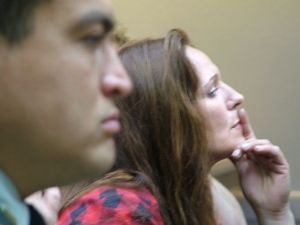
Sharon Lodenbaugh, a friend who’s a former inmate speaks up for her now. “She’s able to develop coping skills, and I know for myself how important that is.”
Other inmates do seek her out: ‘Go ask ‘Tea.’ She’ll know what to do.”
Mary Plante, an ex-journalist, speaks about the trial. She says the reporter covering the case thinks Teafatiller got a raw deal because battered woman’s syndrome was never raised at the trial. “I thought it was potentially material in the level of charge as well as the sentencing.”
She considers Teafatiller a friend; they’ve known each other about 3 1/2 years.. They’re involved in a prison program called New Connections.
Joan Lobdell, who has owned prison-industry businesses, has known nearly 500 inmates over some 25 years. This is just the second time she’s chosen to speak for an inmate. “She should be out. I’ve spent eight hours a day, five days a week, over five years with her. … She was one of the best employees that I’ve ever had.”
Now it’s time for “Tea” to talk.
She’s interested in doing hazardous-cleanup work. “I have several resources,” she says. “I just need to get out.”
Her ex-husband has stayed neutral in regard to the clemency petition, she says. She used to regularly correspond with her daughters but hasn’t heard from them in 1 1/2 to 2 years.
Amanda Lee has a question about contact with the kids once she’s released. They’re 15 and 16 now, but a restraining order is in place until they turn 18 — as a result of the original judgment.
Has she accepted responsibility for her crime? “She has talked about it in therapy, dealt with it very effectively and put the major traumas behind her,” the professor says.
Cain, the attorney, wraps up. He didn’t want to like her, based on her crime. But he’s changed his mind. “The crime itself was a shocking crime … but when she came out of it, she did call her sister, she did take her children to the hospital,” he says. “I think a sentence of the time she’s already done would have been the appropriate sentence.”
It’s the board turn.
Lee speaks first. She’s impressed with the strides that Teafatiller has made, and while she’s reluctant to criticize a trial in which a diminished-capacity defense was raised, she feels “the punishment was excessive.”
She’s leaning toward clemency.
Smith now talks. “I’ve been convinced that we’ve gotten the information that supports a recommendation of clemency to the governor,” she says. She’s impressed with the professor’s expertise and testimony, citing her as a noted regional authority on PTSD and battered women’s syndrome. She doesn’t play that card lightly, Smith notes. “I am very persuaded by her testimony today. … It puts into context Ms. Teafatiller’s conduct then, and the unlikelihood that she would be a danger in the future.”
She makes a motion for clemency, on two conditions: 1) She be supervised by the state Department of Corrections to ensure that she gets mental-health counseling; and 2) She waits 18 months for a smooth, slow transition back to society.
Smith is also impressed by the testimony of those who have supervised her work in prison. “The transformation of Ms. Teafatiller is impressive,” Smith says.
Lee seconds the motion.
Turner says he’ll vote no. He agrees that the 40-year sentence was excessive, but “this was a horrendous, incomprehensible act,” he says. He’s also concerned that the family hasn’t stepped up for Teafatiller.
“I can’t do it. I’m sorry,” he said.
The final vote: 2-1 for commutation.
*****
3:13 p.m.
Next case: Willard Jimerson Jr. He’s the Seattle kid who, barely 13 years old, fatally shot a girl in the back as she tried to flee a melee. That was in 1993. He’s now 29 years old and imprisoned at McNeil Island.
Terry Rogers Kemp is his attorney.
“Despite he’s going in at age 13, he’s grown in spite of his difficulties, has had many great achievements, has exhibited great remorse, and had great success in prison,” Kemp says.
Earliest possible release date: 2014.
In March 1994, Jimerson and other kids were out in a park just before midnight, messing around. They’d been drinking 40-ounce bottles of Old English and smoking marijuana. They came upon Jamie Lynn Wilson, who was minding her own business, but a young girl with Jimerson’s group decided to revive a school dispute she had with Wilson. She was confronted, alone, by the group. She broke away and ran from the fight. After a long run, she tired and the others caught up to her and beat her up. Jimerson was holding the coats of the fighters. Then, he found a gun in one of the coats — and shot at Wilson, killing her. He was charged with aggravated first-degree murder.
“The death of Jamie Lynn was very difficult for Willard to come to grips with it. he maintained denial through the trial and afterwards,” Kemp says. In fact, he stepped up and admitted what he did only after seven years in prison, she adds.
He was largely raised by his grandparents. His parents, who are here, admit they played a major part in who he is today — after all, they didn’t make sure he was home and in bed that night.
Willard was called “penitentiary bait.” That’s in part because his family name is notoriously prominent with Seattle police, Kemp says. Hid dad, in particular, was a rock star of a criminal to kids Willard’s age. Both parents were drug addicts and alcoholics who had no interest in raising a child, she says.
He received a number of infractions during his first years of incarceration, at Maple Lane School near Chehalis.
But now? He’s finished high school, with a 3.6 GPA. He has a community college diploma and several certificates in the general trades. He’s also become a leader, taking charge of Juneteenth observances in prison.
Now Pastor Kenneth Branfer(?) of the Mount Baker Zion Baptist Church in Seattle is talking. A child of gang-infested streets himself, he’s known and worked with the Jimersons for 14 years.
I sure wish he’d get to the point. He’s spent about 15 minutes talking about his background and his philosophies.
“The truth of the matter is that he was a child tried as an adult, but it doesn’t make him an adult with the mind of an adult,” the pastor says. “But now he is an adult … very rarely does he blame his parents. He owned up and took responsibility. He always talked about his responsibility in this heinous crime.”
“I owe it to Jamie” to live a good life, Willard says, according to the pastor.
He himself has lost a brother to murder, and he says forgiveness is paramount.
“We need young men like Willard Jimerson who have changed their lives and beaten the odds and have a word for pyoung eople in trouble,” he says. “He is a highly intelligent young man. I believe he has the werewithal to turn a lot of lives around.”
(I’m really surprised that they’re letting the pastor drone on. It’s 4 p.m. and there are still three more cases ahead of this one. And this one’s nowhere near wrapping up. When will we end today?)
His first cousin aka “older sister” Emijah Smith speaks. “I was blessed not to have similar parents,” she says.
“He has always talked to me and shown remorse to me,” she adds. “Willie wants to show our family and our community that he’s a benefit and not a danger.”
Where will he live? My door is open, she says. An uncle with a body shop will offer a job.
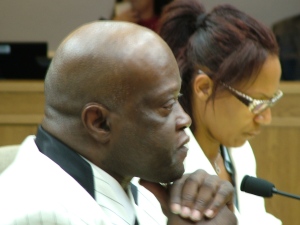
Now it’s Willar Jimerson Sr.’s place to speak.
“I was a bad father,” he says, acknowledging his drug-and-alcohol past, “and if I’d been there for him, this whole tragedy might not happened. I should have been there to give him the guidance and love that every child deserves from his parents.
“I should have been there. I should have been there.”
He wants to make up for lost time. He’ll help with money, jobs, emotional support.
“I want to do everything now that I couldn’t do then for my son,” he says.
Now it’s Willard’s time to talk, by speakerphone from McNeil Island.
“I accept full responsibility for my actions, and it’s because of my actions that I feel ashamed.”
Then he broke down in a fit of sobbing, and many in the audience sobbed along with him.
“I’m sorry for what I did to the Wilson family, and I’m sorry for what I did to my community,” he said once he regained his composure.
“Jamie Lynn did not deserve to die.”
Kemp gently prods him to talk about the future. He wants to go the University of Washington to study psychology and sociology, to help him work with at-risk youth. Eventually he wants to operate his own nonprofit enterprise that works with the whole juvenile-services community.
“From this experience, I’ve gained the knowledge to help other young people fill in the gaps in their lives,” he says. “I know I’ve got a lot to do to build up my credibility in that regard.”
But for now? “I’ll work at McDonalds, and ain’t nobody ever going to outwork me,” he says. “I’ll spend so many hours there that they’ll call me Mister McDonalds.”
Now, it’s deliberation time. Tough one. I can’t predict it.
Turner moves for commutation — in 18 months, so he can get the same ease-into-society training that they want Patricia Teafatiller to have.
Smith agrees, citing his young age and lack and parenting, and his “unfortunate experience” going into the adult corrections system and somehow finding the strength to survive and thrive. She’s also impressed my the pastor’s offer of personal leadership, and the Seattle Central Area-community.
“I think Pastor Ransfer’s question of ‘How long is enough’ is a relevant question, and I find that he’s bee in there long enough,” she says.
Turner has more to say. “I do believe in my heart of hearts that Mr. Jimerson will not go out and commit another crime,” he says. He adds that his vote is somewhat motivated by guilt about voting against another young offender — 14-year-old Barry Massey, in 2007. (I need to look up that case; I missed that hearing.)
Lee isn’t quite as easy a sell. But she’s leaning toward the majority. “I have no doubt that Mr. Jimerson does not pose a threat in the future,” she says. But she says she still wants still to be persuaded.
In the end, it’s 2-1, with Smith and Turner for commutation, and Lee against.
It’s now up to the governor. And believe me, it’s no slam-dunk.
*****
4:36 p.m.
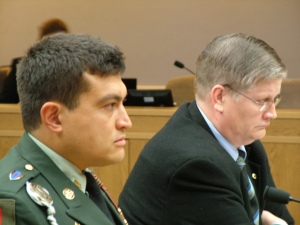
Next up: Steven Anderson. Kenneth Rossbeck, a Tacoma attorney, is representing him.
Eleven years ago, he came home on emergency leave from an Army deployment, back to Fort Lewis. His first wife had been assaulted by a man they know. He was told not to contact the man, a good friend, but he did anyway — talked to him through the door. That didn’t go well, so Anderson broke down the door and assaulted the former pal. Police reports mention a knife, but it never turned up.
Anderson insisted on owning up to what he did, Rossbeck says. They pleaded first-degree burglary down to second-degree, but “it’s still a very serious felony.”
The victim, by the way, did not have to be hospitalized.
Anderson had trouble completing probation requirements because of his Army deployments. In Iraq, he won a Bronze Star and several other medals. He saw close combat, including a close friend die. “He acted with extreme bravery,” Rossbeck said.
The military could have let him go, but Anderson convinced the brass he could be an asset. He served two enlistments. (He’s still wearing a uniform … at least at today’s hearing, but it’s implied that he’s no longer in the service. Huh?)
“The victim has been contacted … and is not opposed to my Anderson receiving clemency,” Rossbeck says. “They even parted on somewhat good terms.”
The Pierce County Prosecuting Attorney is not opposed to the clemency bid.
He’d like a pardon, plus the restoration of civil and gun rights.
Anderson speaks. “I would just like to be a productive civilian,” he says, “I want to be able to vote, want to teach my son to hunt in five or six years, be able to fill out job applications and not have to mark ‘convicted felon.'”
He says his felony has cost him jobs.
“I am sorry for my actions 11 years ago,” he says. “I have been in situations where there’s been a lot more going on and I’ve been able to keep a cool head.”
His wife speaks.
“He’s been a very good father and a good husband,” she says. “He’s a good person.”
Nobody’s here to speak against him.
Amanda Lee makes a motion for a pardon. She’s persuaded that his ervice in Iraq is “extraordinary.” Plus, the offense was committed out of something “quite understandable … an assault upon his wife.”
Smith seconds the motion. It’s an unanimous decision.
His wife softly weeps, and kisses him.
*****
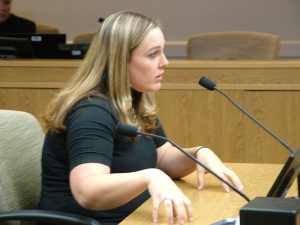
Jamie Crawford is next. She’s seeking a pardon for several offenses related to the same act, she says. Contempt of court, forgery, rendering criminal assistance, bail jumping, “all related to meth,” as Turner points out. The crimes occurred in 2003 and 2004.
She has federal charges, but the state charges have to dealt with first. Next stop: A presidential pardon.
The forgery is the only felony.
She wants to become a nurse.
She grew up in an upper-middle-class family, a good student and a standout athlete. And she started on meth at age 15. “I was hooked instantly, and my life was a complete disaster. I was doing it to lose wight, and the next thing I knew, I lost five years of my life.”
What could have changed her then? Be stricter, she says. “Make me accountable.”
She was 18 when the forgery happened. She was in jail for rendering criminal assistance just before that. “Months later, I was in jail on federal charges.”
“That’s when I decided, I’m not going to let this lifestyle take me.”
Her rebuilding began in March 2005, doing street outreach in Yakima. “That was one way of giving back to my community.” She’s also repaid “every penny, over $10,000” of her restitution and fees.
In January 2006, she was asked to speak at high schools around the state about the dangers of meth. “Just being able to speak out and help them, just made my day,” she says.
“I have changed my life around,” she says. “I have two beautiful kids.”
She’s been in a nursing program but she can’t take the clinicals portion until she clears away her felony. She too has struggled to find jobs, and knows for a fact that she’s been bounced because of her felony. “If you had forgery on your record, would I want to hire somebody like you?”
Deliberation time ….
Not yet. Her mother wants to speak. “She was an angel from birth to fifteen. … Then we hit fifteeen. She was supposed to be at Young Life; instead she was at a party. It was five years of tremendous heartache.”
She changed “on a snap” because of divine intervention.
She works at mother’s CPA office, and “I have complete confidence in how she handles my records.” She’s a “wonderful mother.” The transformation, she says, “is absolutely incredible.”
She has a letter of support from state Attorney General Rob McKenna, among others.
Turner is persuaded, in equal parts because all of her offenses came from one crime, and because of her “extraordinary” efforts to repair her life.
Smith won’t argue. “I’m just so impressed by the Generating Hope for the homeless program you’ve started, all the hard work you’ve done with those people.”
The vote: 3-0 for a pardon.
I’m done, and I’m pooped.
Pizza time.
Thanks for hanging with me today.
Read Full Post »



 Yes, there really are that many loops of razor wire all over
Yes, there really are that many loops of razor wire all over  In my 20-plus years as a Washington journalist, I’ve been to the prisons in Shelton, Walla Walla and Monroe to cover stories for newspapers and interview inmates. I’ve been to the Washington Corrections Center for Women near Gig Harbor more than 20 times (and will be back next week; more on that later). But that rainy Monday marked not only my first trip to McNeil, but my first visit as a citizen rather than a journalist.
In my 20-plus years as a Washington journalist, I’ve been to the prisons in Shelton, Walla Walla and Monroe to cover stories for newspapers and interview inmates. I’ve been to the Washington Corrections Center for Women near Gig Harbor more than 20 times (and will be back next week; more on that later). But that rainy Monday marked not only my first trip to McNeil, but my first visit as a citizen rather than a journalist. Because I was “just” a visitor this time and not going over as a member of the media (arranging formal prison interviews is a far more complicated process), I had to leave all the tools of my trade — notepad, pen, camera and digital recorder — behind in a locker on the Steilacoom side of the water. A shuttle bus then took me and a dozen or so other inmate visitors to the ferry terminal, about 15 miles south of Tacoma, and we boarded the passenger vessel Neil Henly — named for a former McNeil superintendent — for a crossing of about 25 minutes.
Because I was “just” a visitor this time and not going over as a member of the media (arranging formal prison interviews is a far more complicated process), I had to leave all the tools of my trade — notepad, pen, camera and digital recorder — behind in a locker on the Steilacoom side of the water. A shuttle bus then took me and a dozen or so other inmate visitors to the ferry terminal, about 15 miles south of Tacoma, and we boarded the passenger vessel Neil Henly — named for a former McNeil superintendent — for a crossing of about 25 minutes.








